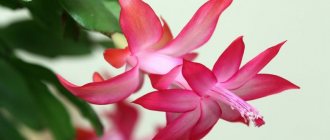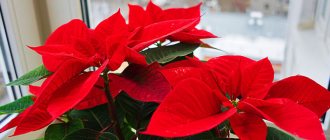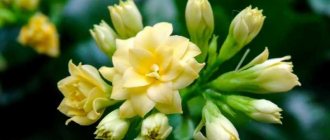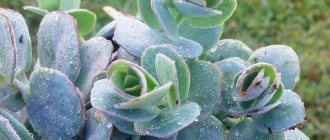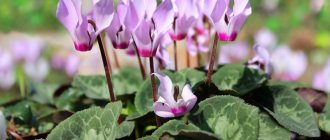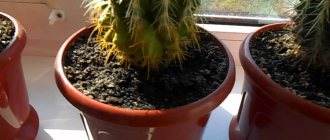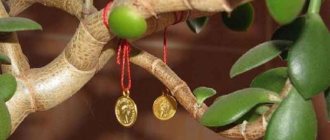Photo: ezo4u.ru At first glance, cyclamen can be confused with an ordinary homemade violet. But it’s enough to take a closer look to notice the differences in the bizarre shape and delicate texture of the petals. A sunny flower gives joy, smiles and dilutes gray everyday life with colors even in the coldest and gloomiest winter. Let's take a closer look at it!
general characteristics
Indoor flowers Cyclamens are perennials, and therefore require more detailed care. The flower description includes several of the following parameters:
- The ground part is represented by oblong green leaves. On the surface of each leaf there is usually a silvery pattern.
- Flowers are presented in the form of single inflorescences, which are located on long thin “legs”.
When replanting, you will notice that the root system of the plant is tuberous and very powerfully developed. The flowering period can occur in winter or spring, which is determined by the type of indoor crop.
Features of the flower
Cyclamen, or alpine violet, is a herbaceous perennial of the Primrose family. It has been used in floriculture since the 16th century, but only in the second half of the 19th century did active work on the selection of garden and indoor varieties begin.
Petals can be painted in different shades
The flower has gained popularity due to the attractive shape and color of the leaves in combination with single bell-shaped flowers, twisting around its axis. The petals can be colored violet, red, purple, white or yellow. The buds form in winter or early spring, depending on the species, and remain fresh for up to several months. Cyclamen extract is used in medicine to create medicines for sinusitis.
The root is represented by a flattened round corm. It contains useful substances used for the preparation of medicines.
Habitat
There are about 50 species in the cyclamen genus. It is found naturally in the Mediterranean, Northeast Africa, Iran, Turkey and Russia. The plant prefers mountainous areas and light meadows located far from bodies of water, since humidity is detrimental to the tuberous root system.
Cyclamen can be found in forests and mountainous hills of the southern regions of Russia
Specifics of growing in an apartment
Cyclamen is an unpretentious plant that even a beginner can handle growing. The tubers contain poisonous juice, so it is not recommended to place the container with the flower in apartments where there are active pets. When transplanting, you should follow simple safety rules - wear gloves, wash your hands with soap after work.
Interior use
Almost all varieties of cyclamens are used as indoor potted plants; planting in open ground is not recommended. The plant is suitable for creating group flowering compositions; low-growing varieties fit into minimalist interior design. The advantage of this culture is its winter and early spring flowering, when most plants are still in the dormant period.
The plant fits perfectly into a minimalist interior style
Lighting requirements
There are several important features in growing the cyclamen plant. For active flowering, the plant needs sunlight, but excess direct sunlight can cause burns and death of the crop.
The most optimal place for placing a flower pot is a window sill on the western or eastern side of the house, where a large amount of diffused light enters.
Temperature
Unlike most indoor plants, this representative prefers slight coolness, which should be taken into account when caring for it at home. The healthiest growth of a lush crown and the development of a beautiful inflorescence can be observed only at air temperatures in the range of 10-15 degrees. In the summer season, cyclamen can tolerate temperatures up to 25 degrees, but with regular ventilation of the room.
Organization of optimal watering
For proper growth and development, as well as disease prevention, watering must be optimally organized. How to water a flower:
- Water intended for irrigation is preliminarily settled for several days.
- It is important to ensure that the water temperature remains at 16-18 degrees.
- The most abundant watering should be during the flowering of cyclamen.
- In organizing care, it is necessary to find a “golden mean”: moisture should not stagnate in the flower pot, but the plant does not tolerate drought well.
An excellent solution for growing at home would be to carry out bottom watering through a tray. With this approach, water does not come into direct contact with the root and above-ground part of the plant.
Cyclamen loves high air humidity, so experts recommend spraying the bush with a spray bottle. However, this technique is used only before flowering, and then the pebbles are moistened in a tray.
Beneficial features
have long been recognized in medicine. Medicines against sinusitis and sinusitis, as well as similar diseases, are prepared from its tubers. Juice from cyclamen tubers allows you to quickly destroy harmful bacteria and organisms that can provoke infectious diseases of the nasal cavity.
On a note. Even the ancient Romans carried cyclamen tubers with them, because it was believed that such people could protect themselves from slander and slander.
When cyclamen comes into contact with the mucous membrane in the body, the juice can completely destroy pathogenic elements of microflora in the stomach and intestines.
Applying fertilizers to the soil
Caring for crops indoors also includes fertilizing. Such a brightly flowering plant undoubtedly requires regular feeding. In practice, universal complex fertilizers are used.
It is important to ensure that the fertilizer does not contain an excess of nitrogen compounds, which lead to rotting of the tubers. During the period of active flowering, all feeding of the flowering crop is completely stopped.
Care during the dormant period
The indoor plant cyclamen has a dormant period. You can recognize its onset by the drying and complete fall of the leaves. During this period, a number of care rules are followed for the culture:
- Reduce the frequency and volume of watering.
- Arrange regular ventilation of the room with the flower.
- When placing the pot in a bright room, transfer the plant to a shaded place, deprived of bright natural light.
Sometimes another technique is used. After the leaves have completely fallen off, the flower pot is turned 90 degrees and stored in this position until the buds appear.
Known plant species
Have you ever wondered where annual wormwood grows? First, you should find out how many varieties of this plant can be found in nature. In fact, there is a lot, but most people know only annual wormwood (artemisia annua), which can be found almost throughout Russia, especially in arid regions. It is worth noting that some types of this herb are poisonous, so it must be used as a traditional medicine with extreme caution. In total, there are about 400 species of this plant in nature.
- Tarragon is one of the types of annual wormwood, which is actively used in cooking. The unique taste and unique aroma of this plant give dishes an exquisite taste. Tarragon is also used in winemaking.
- A rather interesting type of medicinal herb is the so-called “God’s tree”. In some summer cottages it can be found as an ornamental plant. The smell of this herb is slightly different from annual wormwood.
- Wormwood and bitter wormwood are two varieties that bring maximum benefits to the human body. They are similar not only in appearance, but also in their medicinal properties. They are found almost everywhere in nature. These medicinal herbs are used to prepare oils, decoctions and tinctures that help fight a huge number of different diagnoses.
How to distinguish annual from perennial wormwood? To do this you will need to look at the root system of the plant. An annual grass has no buds, and buds, as you know, are an indicator of longevity. In appearance and smell, the herbs practically do not differ from each other, but the medicinal properties of annuals are much higher. Therefore, if you decide to make a decoction or infusion from a medicinal herb, it is recommended to use wormwood.
How to transplant cyclamen
One of the most important practical issues in caring for cyclamen is how to replant. Irrational replanting of an indoor flower can lead to mechanical damage to the root system, as well as to the death of the plant.
The correct sequence for transplantation is:
- This procedure is carried out every year in the last month of summer.
- The new flower pot should be wide enough so that the roots are not compressed.
- The prepared container is filled with slightly alkaline soil.
- It is important to organize a high-quality drainage layer (this can be expanded clay, pebbles).
- The composition of the nutrient soil must necessarily include peat, sand, and humus in the optimal ratio.
- The plant is carefully removed from the old pot, being careful not to damage the roots.
- The tubers are carefully examined, rotting and painful areas are removed using scissors.
- When planting tubers, it is better to leave the roots protruding one third above the soil surface. This approach contributes to more luxuriant flowering of the bush.
The buried roots are sprinkled with prepared soil and watered with settled water.
Subtleties of the reproduction process
Cyclamen was created to delight people with its mesmerizing beauty.
Cyclamen is propagated according to the standard scheme: either by seeds or by dividing the tuber. Experts note that this process is extremely difficult and does not always go perfectly, so the first flower should not be propagated in this way. Seed propagation is suitable for all varieties, but tuberous propagation should be used only for European, Caucasian and Persian flower species.
Cyclamen delights with its beauty
ADVICE! You can divide the tubers only after the cyclamen flowering stops and the plant goes into a dormant state.
A bright spot of cyclamen flowers among forest greenery
The mother tuber of cyclamen is divided into several equal parts - according to the number of buds. It is important to dry the sections of the resulting mini-tubers and treat them with an antiseptic to prevent infection of the new plant. Only after this can the finished small tubers be planted in the soil. Growing cyclamen from seeds is carried out according to a strict scheme: select large seeds, soak in manganese for 15 hours and sow in boxes with prepared loose soil to a depth of no more than 1.5 cm.
The flowers are very original: pointed, curved back, sometimes fringed petals give the impression that a flock of exotic butterflies is circling over the plant
Growing cyclamen from seeds
Most often, cyclamen is purchased at a houseplant store. However, if you wish, you can grow a flower crop from seeds at home. For high-quality and healthy growth, it is better to purchase planting material in a specialized store. Step-by-step growing a plant from seeds:
- The finished seeds are immersed in a sugar solution. Remove the seeds that float to the surface.
- The further task is to soak the seed material in a growth stimulant solution.
- Seeds are placed in the top layer of prepared soil and sprinkled with a thin layer of soil.
- The container with the planted seeds is covered with glass or wrapped in plastic wrap.
- After the first shoots appear (after about 45 days), the container with the plants is removed to a cool place with diffused light.
- At the stage of 2-3 leaves, they are picked into separate pots.
- After a week, young seedlings must be fed with universal fertilizer.
Plants are transplanted into permanent flower pots in the last days of spring. With proper care, flowering is observed after 15 months of bush growth.
Diseases and pests
The main pests of alpine violet are presented below.
Cyclamen mite
This pest is so microscopic in size that it can create the appearance of dust covering the underside of the leaves. In the future, it causes curling and wilting of the sheets. Mites that parasitize flower crops thrive in dry conditions. To get rid of them completely, raise the humidity level around the plant. Affected leaves should be removed.
Aphid
These insects draw sap from the plant, leaving a sticky secretion on the leaves. If the aphid clusters are small, care involves washing the leaves with soapy water. In case of significant damage, cyclamen is immediately treated with an insecticide to prevent the proliferation of pests.
Thrips
Brown spots and distorted leaves may indicate thrips infestation. The larvae of these small flying insects feed on plant sap. To get rid of thrips, cyclamen needs to be sprayed with chemical compounds every five days.
In addition to pests, alpine violet is affected by a number of fungal infections. Fusarium, wet and gray rot are especially troublesome.
Wet rot
The most dangerous disease, since no means of eliminating it have been found. It causes sharp wilting of the leaves, rapid rotting of the tuber and death of the roots. Cyclamen affected by wet rot must be disposed of immediately so as not to infect other flowers.
Gray mold
The source of gray mold is the wetting of leaves and tubers during overhead watering. Infection by this type of fungus is indicated by a gray coating, yellowing of the leaves, and darkening of the petioles. To revive cyclamen, you need to remove the diseased parts and treat them with special fungicides.
Fusarium
Yellowing of cyclamen is one of the first signs of the presence of the fusarium pathogen. The disease then progresses to stunting and wilting. Some gardeners advise using a 0.1% solution of foundationazole to get rid of fusarium. However, if the damage is severe, it is better to eliminate the plant, as it is difficult to treat. To prevent fusarium wilt, the drug trichodermin is added to the prepared soil.

